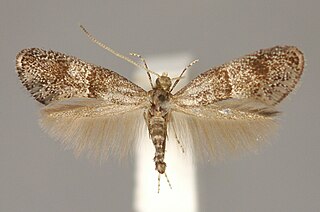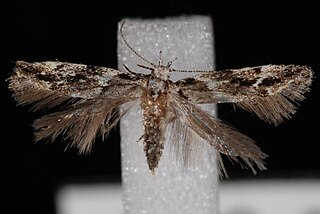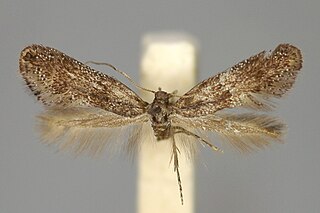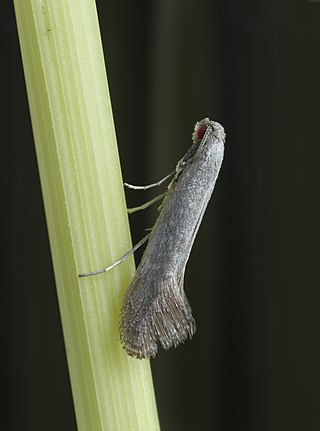
Douglasiidae is a small Lepidopteran family including around 28 species of micromoth whose adults are collectively called Douglas moths. The largest genus in the family is Tinagma. They are primarily found in the Palearctic and Nearctic realms. The adults have a 6 to 15 mm wingspan, with a reduced hindwing venation and long fringes. The larvae are leaf miners or borers, primarily in stems and petioles, belonging to Boraginaceae, Labiatae, and Rosaceae.

Phalacropterix graslinella is a species of moth of the Psychidae family. It is found from France to southern Russia and from northern Italy to Fennoscandia and the Baltic region.

Trifurcula cryptella is a moth of the family Nepticulidae. It is widespread throughout Europe, northwards to southern parts of Norway and Sweden, eastwards to Poland and the Balkan Peninsula, and south to the Mediterranean countries, but there it is rare and confined to mountainous regions. In Italy it has only been recorded from the northern part, in Portugal in the Serra da Estrêla, in Spain in the Cantabrian Mountains and possibly the Sierra Nevada. It is absent from the Mediterranean islands.

Bedellia somnulentella, the sweet potato leaf miner, is a moth in the family Bedelliidae.

Coleophora squalorella is a moth of the family Coleophoridae. It is found from Fennoscandia to Austria, Croatia, Romania and Ukraine and from the Netherlands to the Baltic states. It is also known from the lower Volga and Ural regions of Russia and China. It occurs in steppe and semi-desert biotopes.

Dichelia histrionana is a species of moth of the family Tortricidae. It is found from Fennoscandia to Belgium, Italy and Greece and from the Netherlands to Poland and Romania.

Agonopterix atomella is a moth of the family Depressariidae. It is found in most of Europe.
Monochroa suffusella, the notch wing neb, is a moth of the family Gelechiidae. It is found from Fennoscandia to the Pyrenees and Alps and from Ireland to Romania. In the east, the range extends to Japan. The habitat consists of bogs, fens, swamps and salt-marshes.

Caryocolum junctella is a moth of the family Gelechiidae. It is found from most of Europe east to China and Japan.
Chrysoesthia verrucosa is a moth of the family Gelechiidae. It is found in the Czech Republic, Slovakia, Austria, Hungary and northern Italy. There are also records from Germany and it is possibly also present in Poland.

Monochroa conspersella is a moth of the family Gelechiidae. In Europe, it is found from the Alps to the north. In the east, the range extends to the southern Ural and the Middle Volga, as well as Japan.

Recurvaria nanella, the lesser bud moth, is a moth of the family Gelechiidae. It is widely distributed in Europe and is also found in Turkey, the Near East, North Africa, the Caucasus, Transcaucasia, Kazakhstan and south-eastern Siberia. It is also found in North America, where it is probably introduced.

Scrobipalpa samadensis, the buck's-horn groundling, is a moth of the family Gelechiidae. It is found in most of Europe and Russia.

Tinagma balteolella is a moth in the Douglasiidae family. It is found in Great Britain, France, Belgium, the Netherlands, Germany, Switzerland, Austria, Italy, Spain, the Czech Republic, Slovakia, Croatia, Hungary, Romania, Poland, Lithuania and Ukraine. It is also found in Morocco and Jordan.

Tinagma signatum is a moth in the Douglasiidae family. It is found in the Austria, the Czech Republic, Slovakia, Germany, Italy and Russia.

Tinagma is a genus of moths in the Douglasiidae family. It is primarily found in the Palearctic and Nearctic realms

Tinagma anchusella is a moth in the Douglasiidae family. It is found in Denmark, Germany, Austria, Poland, Bulgaria, Greece, Estonia, Latvia, Sweden, Ukraine and on Cyprus. It is also found in Turkey, Jordan and the Caucasus region.
Tinagma klimeschi is a moth in the family Douglasiidae. It is found in Israel, Egypt and on Rhodes and Cyprus.

Tinagma ocnerostomellum, the bugloss spear wing, is a moth in the family Douglasiidae. It is found in Great Britain, Portugal, Spain, France, Belgium, the Netherlands, Germany, Denmark, Austria, Switzerland, Italy, the Czech Republic, Slovakia, Poland, Hungary, North Macedonia, Greece, Norway, Sweden, Finland, the Baltic region, Ukraine and on Sicily and Crete.
Tinagma gaedikei is a moth in the Douglasiidae family. It is found in North America, where it has been recorded from central Illinois and northern Kentucky.














